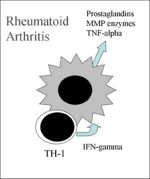Category:Autoimmune Diseases
Introduction
Autoimmune disease is defined as a disease state characterised by a specific antibody or cell mediated response against the body's own tissues ('self' antigens).
The breakdown of tolerance to self antigens and the failure to regulate pathological immune responses are both responsible for autoimmune diseases. It has been shown in mice that thymectomy causes autoimmune disease, and plays a very important role in the recognition of 'self'.
Particular individuals may be more susceptible to autoimmune diseases due to:
Genetic factors
Many autoimmune diseases have a familiar component and the Human Leucocyte Antigen (HLA) haplotype is the predominant genetic factor, however having a particular HLA haplotype does not automatically result in the development of an autoimmune disease.
- HLA-DR3/DR4 (MHC Class II):
1. Diabetes Mellitus
2. Rheumatoid Arthritis
- HLA-B27 (MHC Class I):
1. Ankylosing spondylitis
- TNF alpha
- CTLA-4
Hormonal factors
Testosterone is protective against Systemic Lupus Erythematosus (SLE) and thus it is not seen in males.
Environmental factors
Infection
1. Molecular mimicry
- Some bacteria and viruses have antigens that resemble host-cell components and the body can then also initiate an immune response against itself.
2. Polyclonal activation
- T and B cells activation can occur as a result of an infection resulting in polyclonal activation. This can then cause autoreactive autoantibodies or mediate autoimmunity.
3. Inappropriate MHC expression
- Autoreactive T cells are activated because infection stimulates APC and upregulates MHC class II.
Diet
Stress
| Antibody mediated | Antibody mediated | Cell mediated | |
|---|---|---|---|
| Type of hypersensitivity | Type II | Type III | Type IV |
| Pathogenesis | Antibody to cell surface or matrix antigens | Antibody to soluble self antigens | T cell and macrophage activation to self antigens |
| Examples of diseases | Immune mediated haemolytic anaemia (IMHA) | Systemic Lupus Erythematosus (SLE) | Rheumatoid arthritis |
| Immune mediated thrombocytopaenia (IMTP) | Diabetes Mellitus type 1 | ||
| Myasthenia gravis | Hypothyroidism (lymphocytic throiditis) | ||
| Pemphigus Vulgaris | Hypoadrenocorticism (Addisons disease) | ||
| Bullous pemphigoid |
Antibody mediated autoimmune diseases
1. Immune Mediated Haemolytic Anaemia (IMHA)
Pathogenesis: Type II hypersensitivity
- Autoantibody attack on the red blood cells causing extravascular and intravascular lysis which causes anaemia.
- The in saline autoagglutination test and the coombes test is used to diagnose the disorder.
2. Immune Mediated Thrombocytopaenia (IMTP)
Pathogenesis: Type II hypersensitivity
- There is an immunological attack on the platelets which reduces the ability for clotting.
- A reduced platelet count and detection of anti-platelet antibodies in the serum are used for diagnosis of this disorder.
3. Myasthenia gravis
Pathogenesis: Type II hypersensitivity
4. Bullous Pemphigoid
Pathogenesis: Type II hypersensitivity
5. Pemphigus Vulgaris
Pathogenesis: Type II hypersensitivity
6. Systemic Lupus Erythematosus (SLE)/Multi-systemic immune mediated disease
Pathogenesis: Type III hypersensitivity
Cell mediated autoimmune diseases
1. Rheumatoid arthritis
Pathogenesis:
- Type IV hypersensitivity: CD4 Th-1 cell mediated.
- Macrophages phagocytose self antigens and can present peptides on their MHC Class II molecules. The autoreactive TH-1 cells release IFN-gamma which activates macrophages to release prostaglandins, MMP enzymes and TNF-alpha (pro-inflammatory mediator), see diagram. These cytokines cause inflammation and tissue destruction.
2. Diabetes Mellitus type I
Pathogenesis:
- Type IV hypersensitivity
- The CTLs think that all the beta cells in the pancreas are infected by a virus, as it wrongly detects a self antigen presented by the MHC class I on the surface of the cell as foreign.
- Autoreactive CD8+ CTLs are inadvertently activated, destroying the beta cells, thus preventing the secretion of insulin and causing diabetes type 1 (see diagram).
3. Hypothyroidism (lymphocytic throiditis)
Pathogenesis: Type IV hypersensitivity
- T cell mediated
4. Hypoadrenocorticism (Addisons disease)
Pathogenesis: Type IV hypersensitivity
Subcategories
This category has the following 2 subcategories, out of 2 total.
Pages in category "Autoimmune Diseases"
This category contains only the following page.


